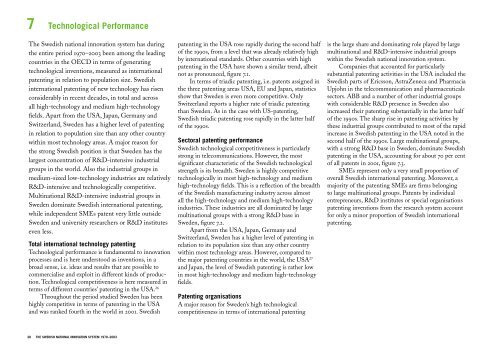The Swedish National Innovation System 1970-2003 - Vinnova
The Swedish National Innovation System 1970-2003 - Vinnova
The Swedish National Innovation System 1970-2003 - Vinnova
You also want an ePaper? Increase the reach of your titles
YUMPU automatically turns print PDFs into web optimized ePapers that Google loves.
7 Technological Performance<br />
<strong>The</strong> <strong>Swedish</strong> national innovation system has during<br />
the entire period <strong>1970</strong>–<strong>2003</strong> been among the leading<br />
countries in the OECD in terms of generating<br />
technological inventions, measured as international<br />
patenting in relation to population size. <strong>Swedish</strong><br />
international patenting of new technology has risen<br />
considerably in recent decades, in total and across<br />
all high-technology and medium high-technology<br />
fields. Apart from the USA, Japan, Germany and<br />
Switzerland, Sweden has a higher level of patenting<br />
in relation to population size than any other country<br />
within most technology areas. A major reason for<br />
the strong <strong>Swedish</strong> position is that Sweden has the<br />
largest concentration of R&D-intensive industrial<br />
groups in the world. Also the industrial groups in<br />
medium-sized low-technology industries are relatively<br />
R&D-intensive and technologically competitive.<br />
Multinational R&D-intensive industrial groups in<br />
Sweden dominate <strong>Swedish</strong> international patenting,<br />
while independent SMEs patent very little outside<br />
Sweden and university researchers or R&D institutes<br />
even less.<br />
Total international technology patenting<br />
Technological performance is fundamental to innovation<br />
processes and is here understood as inventions, in a<br />
broad sense, i.e. ideas and results that are possible to<br />
commercialise and exploit in different kinds of production.<br />
Technological competitiveness is here measured in<br />
terms of different countries’ patenting in the USA. 26<br />
Throughout the period studied Sweden has been<br />
highly competitive in terms of patenting in the USA<br />
and was ranked fourth in the world in 2001. <strong>Swedish</strong><br />
patenting in the USA rose rapidly during the second half<br />
of the 1990s, from a level that was already relatively high<br />
by international standards. Other countries with high<br />
patenting in the USA have shown a similar trend, albeit<br />
not as pronounced, figure 7.1.<br />
In terms of triadic patenting, i.e. patents assigned in<br />
the three patenting areas USA, EU and Japan, statistics<br />
show that Sweden is even more competitive. Only<br />
Switzerland reports a higher rate of triadic patenting<br />
than Sweden. As in the case with US-patenting,<br />
<strong>Swedish</strong> triadic patenting rose rapidly in the latter half<br />
of the 1990s.<br />
Sectoral patenting performance<br />
<strong>Swedish</strong> technological competitiveness is particularly<br />
strong in telecommunications. However, the most<br />
significant characteristic of the <strong>Swedish</strong> technological<br />
strength is its breadth. Sweden is highly competitive<br />
technologically in most high-technology and medium<br />
high-technology fields. This is a reflection of the breadth<br />
of the <strong>Swedish</strong> manufacturing industry across almost<br />
all the high-technology and medium high-technology<br />
industries. <strong>The</strong>se industries are all dominated by large<br />
multinational groups with a strong R&D base in<br />
Sweden, figure 7.2.<br />
Apart from the USA, Japan, Germany and<br />
Switzerland, Sweden has a higher level of patenting in<br />
relation to its population size than any other country<br />
within most technology areas. However, compared to<br />
the major patenting countries in the world, the USA 27<br />
and Japan, the level of <strong>Swedish</strong> patenting is rather low<br />
in most high-technology and medium high-technology<br />
fields.<br />
Patenting organisations<br />
A major reason for Sweden’s high technological<br />
competitiveness in terms of international patenting<br />
is the large share and dominating role played by large<br />
multinational and R&D-intensive industrial groups<br />
within the <strong>Swedish</strong> national innovation system.<br />
Companies that accounted for particularly<br />
substantial patenting activities in the USA included the<br />
<strong>Swedish</strong> parts of Ericsson, AstraZeneca and Pharmacia<br />
Upjohn in the telecommunication and pharmaceuticals<br />
sectors. ABB and a number of other industrial groups<br />
with considerable R&D presence in Sweden also<br />
increased their patenting substantially in the latter half<br />
of the 1990s. <strong>The</strong> sharp rise in patenting activities by<br />
these industrial groups contributed to most of the rapid<br />
increase in <strong>Swedish</strong> patenting in the USA noted in the<br />
second half of the 1990s. Large multinational groups,<br />
with a strong R&D base in Sweden, dominate <strong>Swedish</strong><br />
patenting in the USA, accounting for about 70 per cent<br />
of all patents in 2001, figure 7.3.<br />
SMEs represent only a very small proportion of<br />
overall <strong>Swedish</strong> international patenting. Moreover, a<br />
majority of the patenting SMEs are firms belonging<br />
to large multinational groups. Patents by individual<br />
entrepreneurs, R&D institutes or special organisations<br />
patenting inventions from the research system account<br />
for only a minor proportion of <strong>Swedish</strong> international<br />
patenting.<br />
26 THE SWEDISH NATIONAL INNOVATION SYSTEM <strong>1970</strong>–<strong>2003</strong>

















